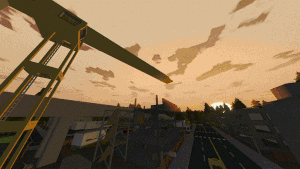Day and night cycle
| S | This is an article stub. | |
|---|---|---|
| This article is lacking in information. You can assist by expanding it. |

The day/night cycle is a game mechanic in Unturned, causing the map to go through periods of light and dark. A full day/night cycle occurs every 60 minutes (3,600 seconds) – twenty-four times faster than real-time. The length and visibility of the daytime and night periods depends on the map, but usually the night is shorter and visibility is significantly reduced. For the PEI, Washington, Yukon, Russia, and Germany maps, daytime and night lengths are the same.
Certain environmental events can only happen depending on the time of day.
Time
Time is measured in seconds, and continues even while the game is paused. Although this quirk does not affect everything that relies on time, the day/night cycle will continue to progress. Certain events such as airdrops may attempt to occur while the game is paused, and unpausing the game will immediately trigger these events. Time depends on the length of the day/night cycle, with the default cycle length letting time range between 0 and 3599. The /time command can be used to manually set the world's current time. If time is set to a number above 3599, it will loop back to the start of the day/night cycle. With the default cycle, this means /time 3600 would be the same as /time 0.
Each second, the sun and moon will move across the sky, as they follow a path going 360 degrees around the skybox and returning to their starting positions by the end of the day/night cycle. This length of this cycle can be changed with the /cycle command. Changing the cycle does not change how often the sun and moon move. Instead, it changes the possible positions of the sun and moon throughout the day. A shorter cycle length reduces the number of valid positions, causing the sun to move a more significant distance with each movement. When the cycle length changes and the current position of the sun or moon is no longer possible, then their positions will round down to the closest valid position in the sky. Regardless of the map's configuration or the length of the day/night cycle, every in-game day begins at dawn.
There is no command to display the current time, but the Clock can be useful when visualizing the time of day. The clock hands will always be accurate to the position of the sun and moon throughout the day, regardless of the cycle length or the ratio between daytime and night periods.
Examples
/cycle 2 will significantly reduce the length of the day to 2 seconds. In this cycle, time ranges from 0 to 1. There are only two valid positions in the sky, which are equivalent to the "0" and "1800" positions on a cycle length of 3600 seconds. Each second, the sun alternates between these two positions.
To emulate real-time /cycle 86400 can be used. A full day will take 24 hours, and there are 24× as many valid positions in the sky for the sun and moon.
Cycle length cannot be set to a negative number. Additionally, attempting to set the cycle length to 0 will instead apply the default length of 3600 seconds. As such, the shortest length possible is 1 second. Time will never change, and the sun will always be at the 6 o'clock position in the sky (i.e., dawn).
Daytime
Daytime lasts for 38 minutes 20 seconds, going from 0 to 2300. Using the /day command will set the current time to immediately after the lighting transitions away from dawn. For maps using the default lighting settings, this is equivalent to using /time 367.
Although environmental events can be limited to daytime hours, most events that are restricted by the time of day occur at night.
Night
Night lasts for 21 minutes 40 seconds, going from 2301 to 3599. Using the /night command will set the current time to immediately after the lighting transitions away from dusk. For maps using the default lighting settings, this is equivalent to using /time 2668.
It is more difficult for players to see during the night due to there being less natural light. The darkness does not affect zombies or animals however, and they can be alerted just as easily as during the daytime. A number of items produce light, which can be helpful while exploring at night. For example, the Flashlight, Campfire, and Headlamp all function as light sources. Night vision goggles such as the Military Nightvision can also aid in seeing in the dark, without directly benefiting other players.
Certain environmental events can only occur at night, such as the Liberator's lights turning on, Volatiles spawning, or being able to open the soulcrystal door in the St. Petersburg metro.
At the start of each night, the moon phase changes. It switches between waxing crescent, waxing gibbous, full moon, waning gibbous, and waning crescent.
